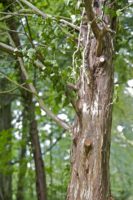Reidinger magnetic pencil & giveaway
You might recognise the name Reidinger from Lexkaliker’s blog. He wrote about their “Pencil Configurator” in one of his previous blog posts. Despite their pencil configurator, Reidinger is not really a pencil manufacturer but is selling pencils, including carpenter pencils, and folding rules as promotional gifts.
The magnet

One of their products is a magnetic pencil, which I got sent by Mr Lorber earlier this month, together with some of Reidinger’s crystal pencils [1]using Swarovski elements. It is a black wood pencil with a neodymium magnet at the end. Unlike Viarco’s or Lexikaliker’s version the magnet is hidden by a metal sleeve and is not directly visible. A metal disc is available and comes with one of the magnetic pencil sets, for sticking to non-metallic surfaces so that the pencil can be placed there. The disc is however not magnetic. A quick attempt to magnetise the disc using the magnetic pencil was unsuccessful (I was hoping to magnetise the disc to be able to use it for Eberhard Faber’s Microtomic or General’s Kimberly pencils). You might know that neodymium magnets are the strongest permanent magnets available and I have to say it is pretty amazing how much these pencils “stick” and what you can do with them: if you can connect two pencils at the end you can swing them around, which is pretty fun.
The pencil

The pencil itself is very good. It lays down a very dark line, is easy to erase and sharpen and is quite smooth, similar to a good pencil, like the Staedtler Tradition or Noris, but short of an excellent pencils, like the Faber-Castell Castell 9000, the Tombow Mono 100 or the Staedtler Mars Lumograph.
After talking to Mrs Morse from Reidinger I found out that many of their pencils are manufactured in Eastern Europe and are made using lime wood [2]American English: Linden wood and was told that the quality of the materials has been certified by TÜV. I am however not sure where exactly the magnetic pencils and the crystal pencils are made. I know that some of the other crystal pencils available are made in China, but to my surprise there seem to be several factories making black wood crystal pencils as Mrs Morse confirmed that their pencils are not from China. Last year my wife bought some crystal pencils from The Pen Shop. They are in her office at the moment – so I cannot check now, but I should have a look and compare them to the ones from Reidinger…

Giveaway
As these magnetic pencils are promotional gifts you cannot buy them individually. I believe you have to buy at least 288 for an order, but since Mr Lorber sent me several of them I am happy to give away a pack of three crystal pencils with Swarovski elements and a magnetic pencil with a metal disc. I am happy to send the prizes to any country as long as Royal Mail doesn’t refuse to send them there. I will use random.org to get a random number and the author of the corresponding article will get the price (unless I am the author or the comment is definitely spam). To take part please leave your comments at this blog post before Sunday, 4th September 2011, 23:59 UTC.
I would like to thank
- Mr Lorber for sending me these pencils and
- Mrs Morse from Reidinger for providing me with more information about Reidinger’s pencils.
- Sean from The Blackwing Pages for the Eberhard Faber Microtomic and the General’s Kimberly pencils I tried to use with the metal disc.
Related information:
- Pencil Talk has a review of different black wood pencils.
- Lexikaliker has DIY instructions on how to make your own magnetic pencil.
Reidinger magnetic pencil & giveaway Read More »




